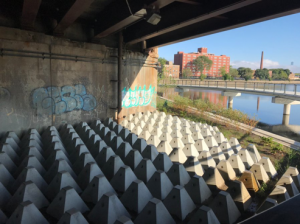Gavin Martin
Associate Editor
Loyola University School of Law, JD 2023
The way we construct our buildings, parks, and communities are reflective of our collective interests and values. Often when constructing public spaces, contractors and city officials employ deliberate methods of design that discourage their use by homeless people, this is known as hostile architecture. From bifurcated city benches to boulders being placed under city overpasses, hostile architecture is an affirmative policy action that is used by cities to discourage and eliminate use of public spaces by those who are unhoused. Collectively, these actions amount to another weapon in the arsenal of government actors in their war against homeless people, instead of homelessness. In order to stop these harmful building and design policies, cities around the United States, including Chicago, should implement regulatory policies banning their use with public funds or through governmental contractors.
Homelessness in Chicago and hostile architecture
In 2019, it is estimated that more than 50,000 people were experiencing homelessness in Chicago. Due to longstanding structural and systemic racism, Black and Brown people disproportionally experience homelessness. In Chicago, an estimated 34,125 Black Chicagoans experienced homelessness throughout 2019, accounting for more than half of the homeless population. Racial minorities are not the only protected classes that are disproportionally represented within homeless populations. For example, nationally, the number one predictor of being under the age of 21 and being homeless is being a part of the LGBTQIA+ community. Additionally, according to the U.S. Department of Housing and Urban Development, more than forty percent of America’s homeless population are people with disabilities. These statistics should position us to see the eradication of homelessness as an issue of Civil Rights, Human Rights, and protecting the most marginalized within our communities.
In Chicago, the designs of parks and construction of public spaces are completed either by government workers at the behest of agencies or departments, or they are completed by government partners and contractors. Regardless, these design policies are actualized in implementation with violent implications for those who are homeless.
Through the use of bike lanes (Appendix A), redesigning benches to make them sleep-deterrent in public parks and transportation areas (Appendix B), and barriers under highway overpasses and bridges (Appendix C), Chicago is filled with a myriad of examples of hostile architecture.
Living without a home necessitates an existence in public spaces. With cities that do little to mitigate the increasing rates of homelessness, hostile architecture is yet another way in which cities can punish the homeless and further complicate life for those who are the most vulnerable in our community.
Policy implementation regulating design and construction
In Chicago, a city-wide ordinance ought to be implemented that bans the use of hostile architecture by government agencies or city contractors working on taxpayer funded projects. Language in said ordinance can be as broad as to ban the use of any public architecture, building, or design plans that discourage usage by those who are homeless. It also can spell out the most widely implementations of hostile architecture, such as slanted benches along CTA routes, bifurcated park benches, and barriers placed in common gathering and sleeping areas of the homeless.
Although any proposed ordinance that bans the use of hostile architecture is necessary to regulate the design of public spaces, this would not necessarily roll back the architecture that currently exists now. This also does not discourage the routine clearing of homeless camps or gatherings by the Chicago Police Department.
However, any policy implementation regulating government agents and contractors use of hostile architecture can only go so far. Instead, a shift in the way in which we see those who are homeless is in order — the circumstances that lead to a person sleeping on a park bench or under a highway overpass should be more of a concern than how to keep them out. The aforementioned proposed ordinance would be a step in the path toward understanding that fighting homelessness is not fighting those who are homeless.
Photo Appendix
Appendix A– Bike lane that is constructed where homeless people used to regularly sleep in Chicago.
Appendix B– Sleep-deterrent bench at Chicago CTA area.
Appendix C– Barriers placed under Lathrop Riverwalk to prevent homeless populations from seeking shelter.



